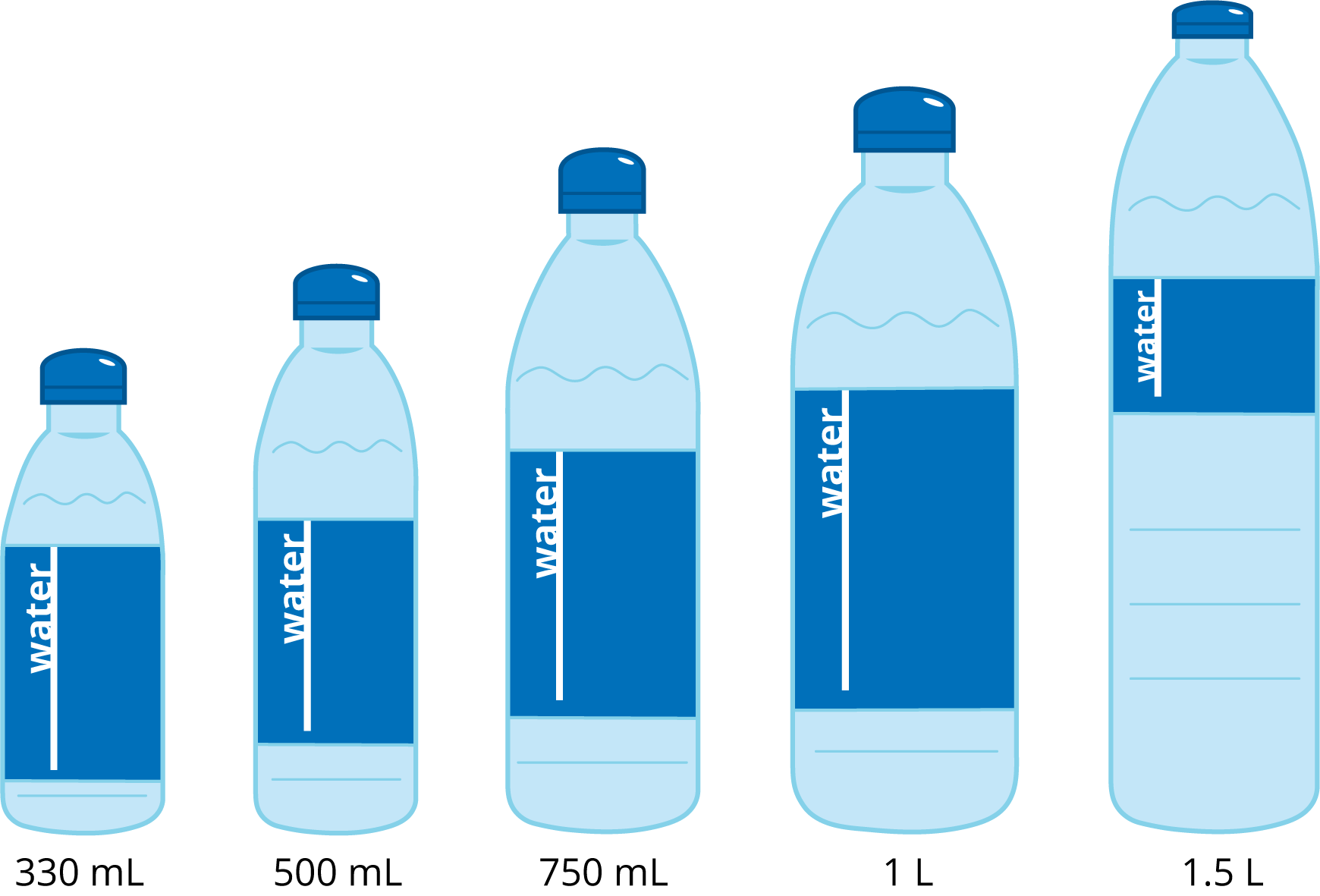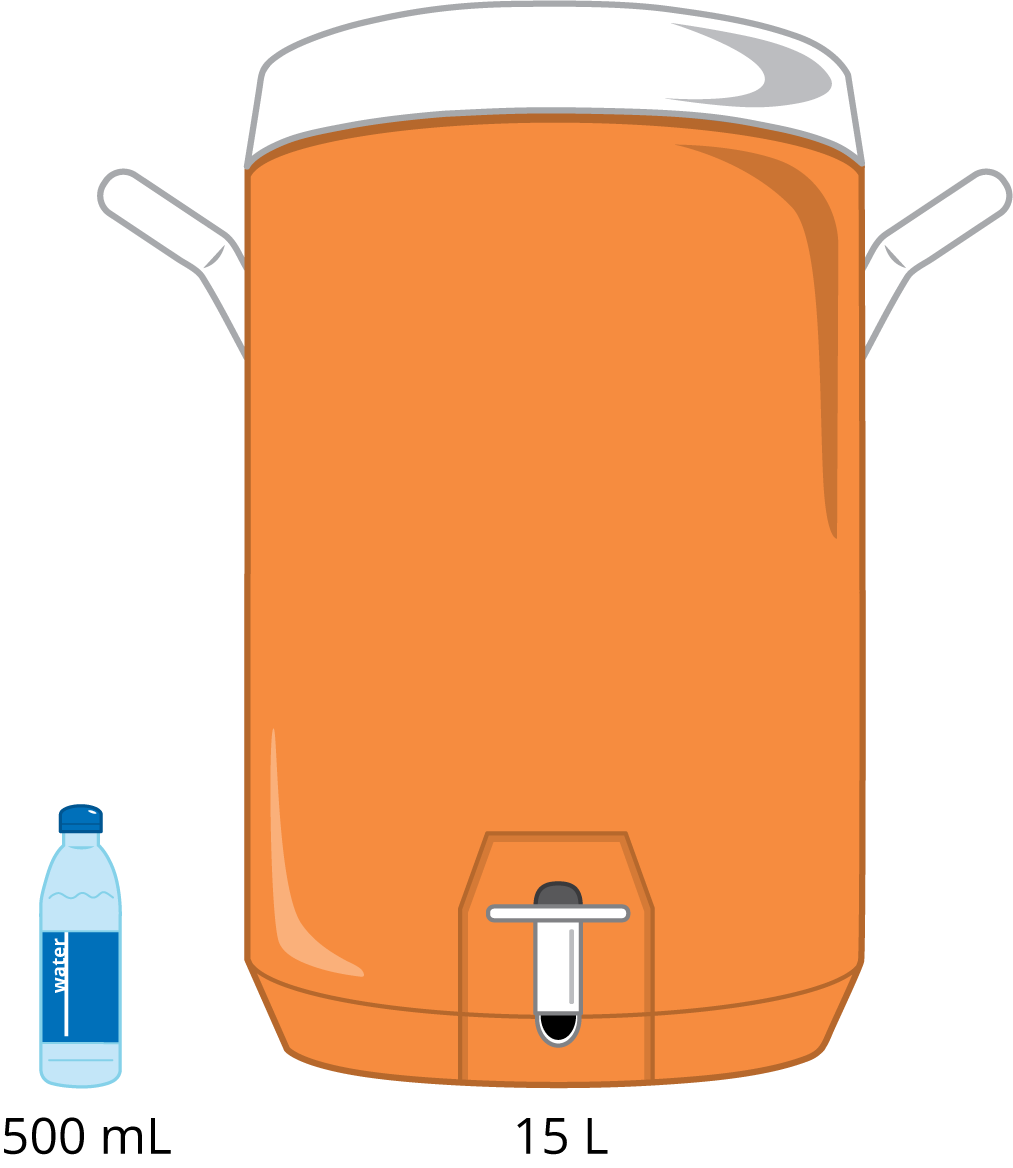Lesson 6
Multi-step Conversion Problems: Metric Liquid Volume
Warm-up: Number Talk: Divide by Powers of 10 (10 minutes)
Narrative
Launch
- Display one problem.
- “Give me a signal when you have an answer and can explain how you got it.”
- 1 minute: quiet think time
Activity
- Record answers and strategy.
- Keep problems and work displayed.
- Repeat with each problem.
Student Facing
Find the value of each expression mentally.
- \(1,\!400 \div 10\)
- \(1,\!400 \div 100\)
- \(1,\!400 \div 1,\!000\)
- \(1,\!401 \div 1,\!000\)
Student Response
For access, consult one of our IM Certified Partners.
Activity Synthesis
- Display: 1,401 and 1.401
- “How are these numbers the same?” (They both have a 1, then a 4, then a 0, then a 1.)
- “How are they different?” (The place values of the digits are different. The value of each digit in 1.401 is \(\frac{1}{1,000}\) the value of that digit in 1,401.)
Activity 1: Liquid Volume Conversions (20 minutes)
Narrative
The purpose of this activity is for students to convert between measurements in milliliters and liters, providing practice multiplying and dividing by 1,000. Students work with numbers in many forms including whole numbers, decimals, fractions, and numbers in exponential form.
Supports accessibility for: Attention; Memory; Social-Emotional Functioning
Launch
- Groups of 2
- Display the image.
- “What do you notice? What do you wonder?” (There are different sized water bottles. There are numbers underneath the water bottles. How much more water does the big one hold than the little one? How many milliliters are in a liter?)
- Display a table like this one:
L mL 1 1,000 10 0.1 100,000 10 - “What numbers go in the empty boxes in the table?”
- 30 seconds quiet think time
- “Explain your thinking to a partner.”
- Fill in the table and leave it displayed for students to refer to during the lesson.
L mL 1 1,000 10 10,000 0.1 100 100 100,000 0.01 10
Activity
- 3–5 minutes: independent work time
- 1–2 minutes: partner discussion
- Monitor for students who:
- compare the quantities by converting milliliters to liters
- compare by converting liters to milliliters
Student Facing

- Complete the table.
L mL 5 6.3 0.95 \(10^2\) 800,000 \(10^6\) 65 -
Decide if the two measurements are equal. If not, choose which one is greater. Explain or show your reasoning.
- 15 mL and 0.15 L
- 2,500 mL and 2.5 L
- 200 mL and \(\frac{1}{4}\) L
- 1 mL and \(\frac{1}{1,000}\) L
- 15,600 mL and 15.5 L
Student Response
For access, consult one of our IM Certified Partners.
Advancing Student Thinking
If students confuse the operations they need to use to convert milliliters to liters or liters to milliliters, refer to the table from the launch and ask, “What patterns do you notice?”
If necessary, add rows to the table and ask them to explain how many milliliters of water are in 2 liters of water and 3 liters of water, and 0.001 liter of water.
Activity Synthesis
- Invite selected students to share how they compared the measurements.
- Display: 15,600 mL and 15.5 L
- “How many liters are 15,600 milliliters? How do you know?” (15.6 since I divide by 1,000)
- “How many milliliters are 15.5 liters? How do you know?” (15,500 since there are 1,000 milliliters in each liter so that’s 15,000 and half of a thousand which is 500.)
- “Which is greater? 15,600 milliliters or 15.5 liters? How do you know?” (15,600 mL because I can compare them using either liters or milliliters.)
- “When you solved this problem, did you convert from milliliters to liters or from liters to milliliters? Why?” (I converted from liters to milliliters because multiplying by 1,000 is more comfortable than dividing by 1,000.)
Activity 2: Rehydrating Dancers (15 minutes)
Narrative
The purpose of this activity is for students to solve multi-step problems involving metric units of liquid volume (MP2). The given quantities involve fractions. One of the quantities involves the fraction \(\frac{1}{2}\) which students may convert to a decimal or they may perform the needed arithmetic with fractions. Students also have a choice of converting to milliliters or liters and there are different points in the calculations when they may choose to make the conversion.
Different approaches students may use to solve the problems include:
- convert the volume of the bottle to liters (as a decimal or fraction) and work in liters
- find out how much each dancer drinks in milliliters and then convert to liters
- find out how much all the dancers drink in milliliters and then convert to liters
- find out how much all the dancers drink in milliliters and then convert the cooler volume to milliliters
The purpose of the lesson synthesis is to compare some of these different approaches.
Advances: Writing, Speaking, Listening
Launch
- Groups of 2
- Display the image.
- “What do you notice? What do you wonder?” (The orange thing is a lot bigger than the water bottle. What is that orange thing? How many bottles of water will fill up the orange thing?)
- “This is an illustration of a water bottle and a water cooler. The orange water cooler can hold a lot of water. We are going to solve some problems about the water in the cooler.”
Activity
- 5–8 minutes partner work time
- Monitor for students who:
- convert from milliliters to liters at different steps in the calculations for the first problem
- convert from liters to milliliters at different steps in the calculations for the first problem
Student Facing
There are 25 dancers in the performance group. During practice, each dancer drinks \(1 \frac{1}{2}\) bottles of water.
- Each bottle holds 500 mL of water. How many liters of water do the dancers drink? Explain or show your reasoning.
-
Each cooler holds 15 L of water. How many coolers does the team need? How much water will they have left over after practice? Explain or show your reasoning.

- The dancers can make a sports drink by mixing 30 mL of drink mix with each 500 mL of water. How many liters of drink mix does the team need for their practice? Explain or show your reasoning.
Student Response
For access, consult one of our IM Certified Partners.
Advancing Student Thinking
Activity Synthesis
- Invite a student who found how many milliliters all of the dancers drank to share their reasoning.
- “How did you figure out how many milliliters of water one dancer drinks?” (I took 500 and then half of 500, or 250, more.)
- “How did you figure out how many milliliters all of the dancers drink?” (I multiplied 750 by 25.)
- “How did you find how many coolers the dancers need?” (I multiplied the number of liters in the cooler by 1,000.)
- Invite a student who found how many liters all of the dancers drank to share their reasoning.
- “How are the methods different?” (One calculates in milliliters and the other one in liters. The numbers with milliliters are much bigger. The numbers with liters are smaller. They are decimals or fractions.)
Lesson Synthesis
Lesson Synthesis
“Today we converted between liters and milliliters and used these conversions to solve problems. We multiplied or divided.”
“We saw two ways to solve the water cooler problem.”
Display student work from the lesson that shows multiplication and division.
“Which strategy do you prefer? Why?” (I liked working in milliliters because then I could use whole numbers. I like using liters because I can visualize a liter and that helps me make sense of the calculations.)
Cool-down: Dance Team (5 minutes)
Cool-Down
For access, consult one of our IM Certified Partners.